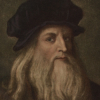Leonardo da Vinci

Leonardo da Vinci
Leonardo di ser Piero da Vinci, more commonly Leonardo da Vinci or simply Leonardoˈvintʃi] ; 15 April 1452 – 2 May 1519), was an Italian polymath whose areas of interest included invention, painting, sculpting, architecture, science, music, mathematics, engineering, literature, anatomy, geology, astronomy, botany, writing, history, and cartography. He has been variously called the father of paleontology, ichnology, and architecture, and is widely considered one of the greatest painters of all time. Sometimes credited with the inventions of the parachute, helicopter and tank,...
NationalityItalian
ProfessionPainter
Date of Birth15 April 1452
CityVinci, Italy
CountryItaly
The painter who is familiar with the nature of the sinews, muscles, and tendons, will know very well, in giving movement to a limb, how many and which sinews cause it; and which muscle, by swelling, causes the contraction of that sinew; and which sinews, expanded into the thinnest cartilage, surround and support the said muscle.
The mind of the painter must resemble a mirror, which always takes the colour of the object it reflects and is completely occupied by the images of as many objects as are in front of it.
The most praiseworthy form of painting is one that most resembles what it imitates.
It reflects no great honour on a painter to be able to execute one thing well.
He who despises painting has no love for the philosophy in nature.
Poetry is superior to painting in the presentation of words, and painting is superior to poetry in the presentation of facts. For this reason I judge painting to be superior to poetry.
Painting embraces and contains within itself all the things which nature produces or which results from the fortuitous actions of men... he is but a poor master who makes only a single figure well.
Nature has placed in the front part of man, as he moves, all those parts which when struck cause him to feel pain; and this is felt in the joints of the legs, the forehead and the nose, and has been so devised for the preservation of man, because if such pain were not felt in these limbs they would be destroyed by the many blows they receive.
Perspective is the rein and rudder of painting.
We may call painting the grandchild of nature.
The painter strives and competes with nature.
If you call painting dumb poetry, the painter may call poetry blind painting.
How painting surpasses all human works by reason of the subtle possibilities which it contains.
After painting comes Sculpture, a very noble art, but one that does not in the execution require the same supreme ingenuity as the art of painting, since in two most important and difficult particulars, in foreshortening and in light and shade, for which the painter has to invent a process, sculpture is helped by nature. Moreover, Sculpture does not imitate color which the painter takes pains to attune so that the shadows accompany the lights.